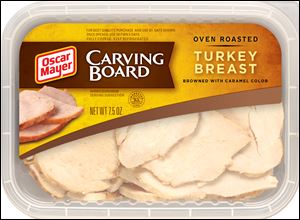
Food companies now aiming for a rustic image
Goal is to appear homemade
6/20/2013
A package of Oscar Mayer Carving Board Turkey Breast shows natural-looking cuts. Kraft Foods spent more than two years to develop the uneven cutting process.
NEW YORK — Here’s the latest goal for food makers: Perfect the art of imperfection.
When stretching out the dough for its premium “Artisan Pizzas,” Domino’s workers are instructed not to worry about making the rectangles too perfect: The pies are supposed to have a more rustic look.
At McDonald’s, the egg whites for the new breakfast sandwich called the Egg White Delight McMuffin have a loose shape rather than the round discs used in the original Egg McMuffin.
Wendy’s softened the edges of its famously square hamburger patties to what it calls a “natural square.”
And Kraft Foods took more than two years to develop a process to make the thick, uneven slabs of turkey in its Carving Board line look like leftovers from a homemade meal rather than the cookie-cutter ovals typical of most lunchmeat.
“The goal is to get the same action as if you were cutting with a knife,” said Paul Morin, a Kraft engineer.
Appearances have always been a part of food production. But some experts say the visual cues food makers are using to suggest their products are wholesome fuel confusion about what’s natural and what isn’t.
“They can’t change the fact that they’re making processed products, so they have to use these other tricks to pretend,” said Michele Simon, a public health lawyer and author of Appetite for Profit: How the Food Industry Undermines Our Health and How to Fight Back.
Food companies are responding to the adage that people eat with their eyes. Americans still love their fast food and packaged snacks, but they’re increasingly turning their noses up at foods that look overly processed. Home-cooked meals — or ones that at least look like they were home-made — are seen as more wholesome and authentic.
The result is that companies are tossing out the identical shapes and drab colors that scream of factory conveyor belts.
Over the past five years, the overall packaged food industry in North America grew 14 percent to $392.5 billion, according to market researcher Euromonitor International. The fast-food industry meanwhile rose 13 percent to $225.6 billion.
In many cases, food products get their wholesome appearance because of the different or stripped-down ingredients companies are using to make them more natural, said Michael Cohen, a visiting assistant professor of marketing at NYU’s Stern School of Business. But in other cases, companies are making tweaks just to achieve a desired look.
“Food manufacturers are adapting by the way they mold the product or the end color or texture they want the product to be,” he said.